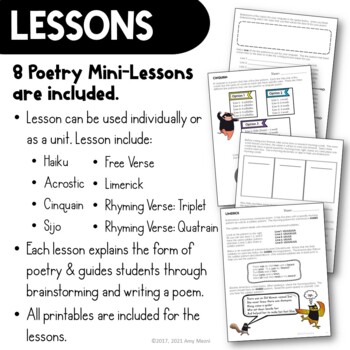Poetry Writing Unit - 8 Poem Templates to Create a Student Book of Poems
- Zip
What educators are saying
Also included in
- Nonfiction and Fiction Genre Book Report Bundle - 9 Different ProjectsEasily differentiate your reading class by allowing students to explore fiction and nonfiction genres. With this bundle, you will have an easy-to-create project for both fiction and nonfiction genres! Adventure BrochureAutobiograpPrice $30.00Original Price $37.50Save $7.50
Description
Poetry Writing Unit: Creating A Book of Poems
This poetry writing unit includes 8 printable lessons that teach students how to write different forms of poetry. Lessons include an explanation of the poetry form, example poems, and templates to guide students in writing an original poem. The unit is included in both PDF & Google Slides.
The featured poems are:
- Acrostic
- Haiku
- Cinquain
- Free Verse
- Rhyming Verse: Triplet
- Rhyming Verse: Quatrain
- Limerick
- Sijo
Each lesson can be used individually or as a unit. If teachers use them as a unit, students read published poets, write poetry, and create their own anthology of poetry.
For the poetry anthology, students need to read at least 3 poetry books. Students will self select at least 3 published poems to add to their "poetry anthology." Students add these poems to the ones they have written to form their anthology.
Also included in this resource are:
- MLA Bibliography
- Student Checklist
- Rubric
- Poetry Book Cover & Table of Contents Templates
This unit is ready to print and copy.
How to Use This Unit
Teachers can use the poetry lessons in a variety of ways, including whole class instruction, small group, or even in writing centers.
My favorite time to teach this unit was during state testing. After the day's testing was over and we had a break, we read poems for 5 - 10 minutes and discussed them. I gave a minilesson on one of the poetry forms. Students could write their poems by themselves or with a partner. I always had strong engagement from students, because they could talk with friends while they worked. It was a nice creative break after concentrating during testing.
*****************************************************************************
Customer Tips:
How to get TPT credit to use on future purchases:
• Please go to your My Purchases page (you may need to login). Beside each purchase you'll see a Provide Feedback button. Simply click it and you will be taken to a page where you can give a quick rating and leave a short comment for the product. Each time you give feedback, TPT gives you feedback credits that you use to lower the cost of your future purchases. I value your feedback greatly as it helps me determine which products are most valuable for your classroom so I can create more for you. ☺
Be the first to know about my new discounts, freebies and product launches:
• Look for the green star next to my store logo and click it to become a follower. Voila! You will now receive email updates about this store. ☺
*****************************************************************************






